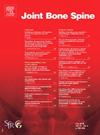Pediatrics hyperuricemia in clinical practice: A retrospective analysis in 1753 children and adolescents with hyperuricemia
IF 3.8
3区 医学
Q1 RHEUMATOLOGY
引用次数: 0
Abstract
Objectives
Serum levels of uric acid (S-UA) are influenced by the interaction of genetic and environmental factors; detailed studies of hyperuricemia in children are rare. This retrospective study aimed to analyze the causes, risk factors, and therapeutic approaches associated with the development of hyperuricemia in childhood.
Methods
In a single-center study, serum uric acid levels were analyzed in 33,900 samples from 13,890 children and adolescents < 19 years (6760 girls and 7130 boys) obtained between 2013 and 2023. Hyperuricemia was defined as S-UA > 370 μmol/L (6.22 mg/dL) in girls and > 420 μmol/L (7.06 mg/dL) in boys; mild hyperuricemia was defined as 370–420 μmol/L in boys < 13 years.
Results
In the analyzed group, hyperuricemia was found in 1753 patients (12.6%), including 586 girls and 864 boys; mild hyperuricemia was found in 303 boys < 13 years. The most common associated conditions were obesity with body mass index > 95th percentile (27.8% of girls, 26.3% of boys) and chronic kidney disease (18.6% of boys, 11.4% of girls). Hyperuricemia was also relatively common in children with connective tissue disorders (10.6%) or different inherited metabolic disorders (10.7%). Transitory hyperuricemia was found in 19.1% of girls and 10.1% of boys with acute gastroenteritis. Urate-lowering therapy was used in 73 children and adolescents with severe hyperuricemia (S-UA 556 ± 107 μmol/L, fraction excretion of UA 3.27 ± 1.98%). Eight treated children had chronic kidney disease, nine were extremely obese, one had combined antiepileptic therapy, and 55 had inherited metabolic diseases, including 26 children with disorders of purine metabolism. The initial daily dose of allopurinol (50–100 mg) normalized the S-UA (350 ± 80 μmol/L) in a majority of children, except for extremely obese adolescents (weight 98–149 kg) where the dose had to be increased to 200–300 mg.
Conclusions
Asymptomatic hyperuricemia is a relatively common biochemical finding in pediatric clinical practice. The etiology of hyperuricemia should be carefully analyzed, and the value of individualized hyperuricemia management and the eventual benefits of urate-lowering therapy in children must be carefully considered.
儿科高尿酸血症临床实践:对 1753 名高尿酸血症儿童和青少年的回顾性分析。
目的:血清尿酸水平(S-UA)受遗传和环境因素相互作用的影响;有关儿童高尿酸血症的详细研究很少见。这项回顾性研究旨在分析儿童高尿酸血症的发病原因、风险因素和治疗方法:在一项单中心研究中,对 2013 年至 2023 年间采集的 13,890 名 19 岁以下儿童和青少年(6,760 名女孩和 7,130 名男孩)的 33,900 份样本进行了血清尿酸水平分析。高尿酸血症的定义是:女孩 S-UA > 370 μmol/L(6.22 mg/dl),男孩 S-UA > 420 μmol/L(7.06 mg/dl);轻度高尿酸血症的定义是:13 岁以下男孩 S-UA > 370-420 μmol/L:在分析组中,1 753 名患者(12.6%)患有高尿酸血症,其中包括 586 名女孩和 864 名男孩;303 名年龄小于 13 岁的男孩患有轻度高尿酸血症。最常见的相关疾病是身体质量指数大于第 95 百分位数的肥胖症(女孩占 27.8%,男孩占 26.3%)和慢性肾病(男孩占 18.6%,女孩占 11.4%)。高尿酸血症在患有结缔组织疾病(10.6%)或不同遗传代谢疾病(10.7%)的儿童中也比较常见。在患有急性肠胃炎的儿童中,19.1% 的女孩和 10.1%的男孩患有短暂性高尿酸血症。73 名患有严重高尿酸血症的儿童和青少年(S-UA 556±107 µmol/L,尿酸排泄率为 3.27±1.98%)接受了降尿酸治疗。8 名接受治疗的儿童患有慢性肾病,9 名儿童极度肥胖,1 名儿童合并抗癫痫治疗,55 名儿童患有遗传性代谢疾病,其中 26 名儿童患有嘌呤代谢紊乱。除了极度肥胖的青少年(体重 98-149 千克)需要将剂量增加到 200-300 毫克外,大多数患儿最初的每日别嘌醇剂量(50-100 毫克)都能使 S-UA 正常化(350±80 微摩尔/升)。结论 在儿科临床实践中,无症状高尿酸血症是一种比较常见的生化检查结果。应仔细分析高尿酸血症的病因,并认真考虑对儿童进行个体化高尿酸血症管理的价值和降尿酸治疗的最终益处。
本文章由计算机程序翻译,如有差异,请以英文原文为准。
求助全文
约1分钟内获得全文
求助全文
来源期刊

Joint Bone Spine
医学-风湿病学
CiteScore
4.50
自引率
11.90%
发文量
184
审稿时长
25 days
期刊介绍:
Bimonthly e-only international journal, Joint Bone Spine publishes in English original research articles and all the latest advances that deal with disorders affecting the joints, bones, and spine and, more generally, the entire field of rheumatology.
All submitted manuscripts to the journal are subjected to rigorous peer review by international experts: under no circumstances does the journal guarantee publication before the editorial board makes its final decision. (Surgical techniques and work focusing specifically on orthopedic surgery are not within the scope of the journal.)Joint Bone Spine is indexed in the main international databases and is accessible worldwide through the ScienceDirect and ClinicalKey platforms.
 求助内容:
求助内容: 应助结果提醒方式:
应助结果提醒方式:


